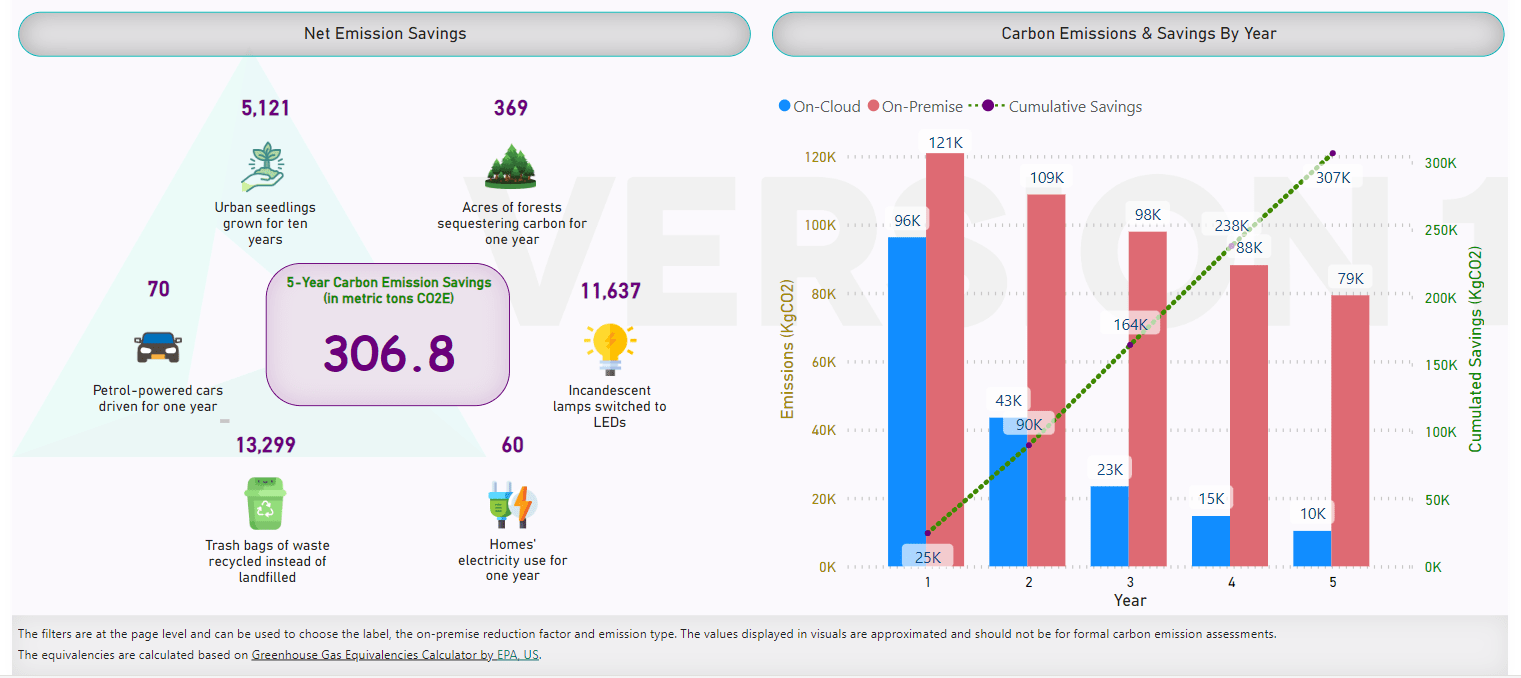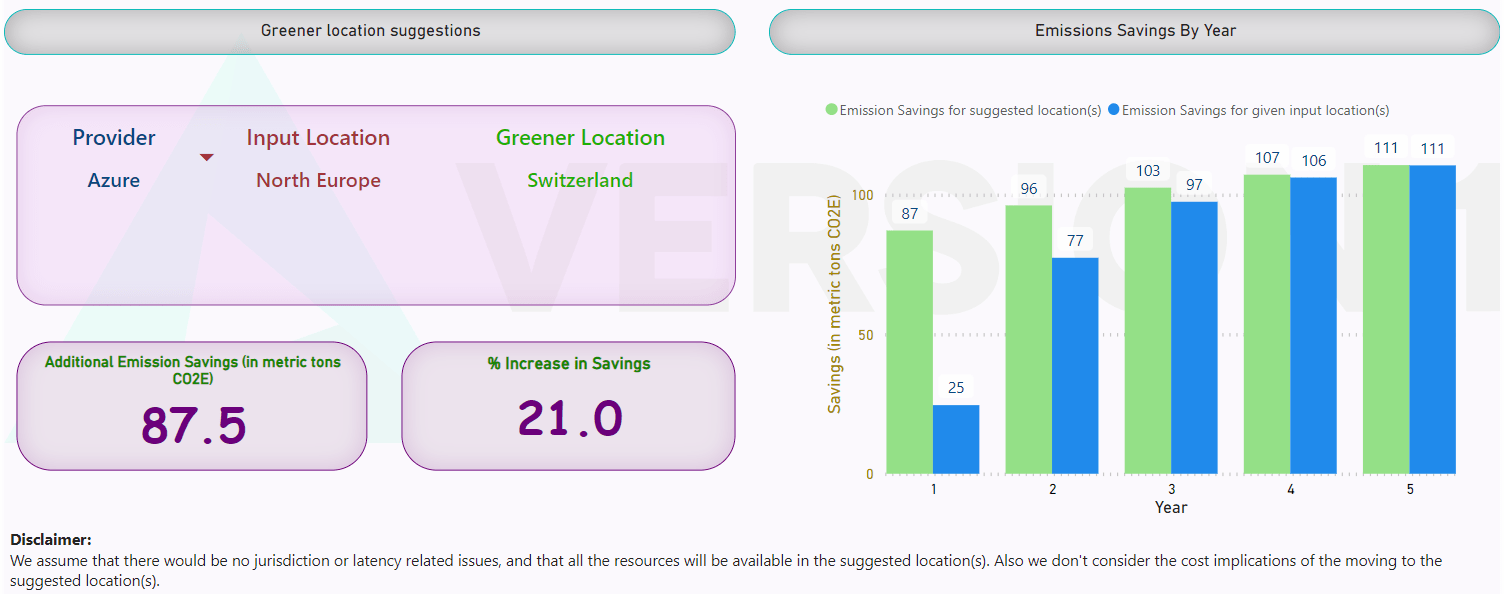4 min read
Discover Your Carbon Emissions Savings with our Calculator
The urgent need for sustainability and accountability
It is a positive sign that technology companies large and small are monitoring their carbon emissions. Organisations have pledged to become net zero in the next few decades by setting ambitious sustainability development goals and becoming part of a global movement to combat climate change and rapid global warming. Everyone from Greta Thunberg to Satya Nadella have called for reliable carbon accounting and have highlighted the urgent need to question how sustainable ‘business as usual’ is.
- “By 2030, we’ll be carbon negative, and by 2050, we’ll remove our historical emissions since our founding in 1975.” — Microsoft
- “We’re on a path to powering our operations with 100% renewable energy by 2025.” — AWS
Version 1 helps customers account for their carbon emissions. One of our award-winning partnerships and key business areas is Cloud Migration. Placing sustainability at the forefront to achieve net zero emissions by 2025, our Innovation Labs created a robust Carbon Emissions Calculator with Microsoft Azure. Our calculator measures your business’ on-premise infrastructure carbon emissions and calculates your saving when you move to the cloud.
Cloud Service Providers keen to become greener
Cloud service providers (CSPs) are aiming to play their part, promising to reduce an organisation’s carbon emissions by moving their workloads to cloud. This is an attractive proposition to organisations. But is there a way to quantify these reductions? There are two benefits:
1. Reduction in operating costs
2. Calculating carbon emission savings.
The cost benefits can be ascertained with in-depth cost-analysis, but what about carbon emission savings?
To address this, CSPs provide some form of carbon footprint tooling to give their existing customers a measure of the carbon emissions from workloads running in the cloud.
- Microsoft — Emissions Impact Dashboard for Azure
- AWS — Customer Carbon Footprint Tool
- Cloud Carbon Footprint(CCF), an open-source tool to measure and analyse your emissions, integrates with the 3 major CSPs.
Organisations can utilise these to identify their progress towards greener operations with their current cloud workloads.
However, what if you want to know the savings you could make by moving to the cloud?
AWS claims up to 88% reduction in carbon emissions, whereas Microsoft stakes this at 98%. Microsoft does provide another tool that takes in a few parameters with regards to on-premise workload and gives you an instant report, but this calculation doesn’t appear to take into consideration your servers’ running times, utilisation, or memory. Neither does it consider the on-premises power usage effectiveness and carbon intensity values, key factors in determining your carbon emissions from IT workload.
With this gap in mind, the Innovation Labs in Version 1 have developed an API which can examine a detailed set of your current workload and migration recommendations to work out your potential carbon emission savings. With the help of another bespoke supporting tool we periodically update datasets, that are used to estimate both on-premises and cloud emissions, from publicly available sources.
We went further and designed a Power BI app to visualise the output of the API.

The API and the visualisation will enable customers to see the potential benefits of moving their on-premise workload to cloud. They also provide comparisons between different cloud regions and even suggest alternative regions – subject to jurisdiction and latency concerns.

The result, with the help of the API and visualisation, is that an organisation can reap the benefits of cloud migration from a carbon footprint perspective in a few years if the CSPs were to stick to their promises of running 100% of their operations with renewable energy by 2025, and becoming carbon negative by 2030.
To sum up, the Version 1 Carbon Emission Calculator can fill in gaps that other calculators fail to account for such as the effectiveness of your on-premises IT power usage and carbon emissions resulting from them. And more importantly, our calculator takes into consideration key metrics such as server running times, utilisation, and memory, that existing calculators do not consider.
Keeping in mind that Cloud migration and cloud operations pose their own challenges, cloud servers are key to developing IT infrastructure that is scalable, secure, and sustainable for decades to come.
Learn more about Version 1’s migration carbon emission savings calculator here.
About Version 1 Innovation Labs
The Version 1 Innovation Labs, established in 2018, demonstrates the ‘art of possible’ by exploring cutting-edge technologies in collaboration with our customers. Our Innovation team works by developing a ‘Proof of Value’ project over a period of up to 12 weeks, enabling the customer to ‘prove the value’ of the technology to their business, focusing on how it can deliver tangible benefits, as opposed to exploring innovation for innovation’s sake.